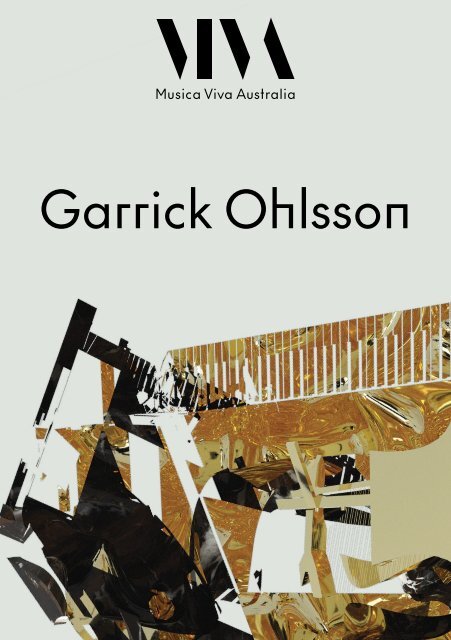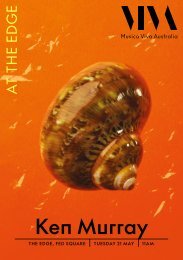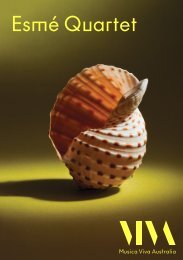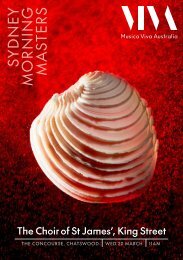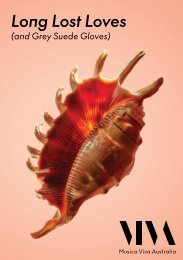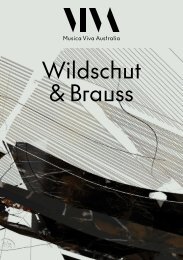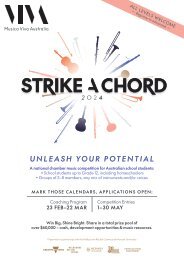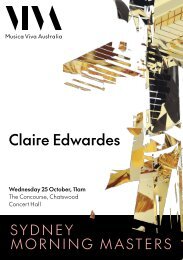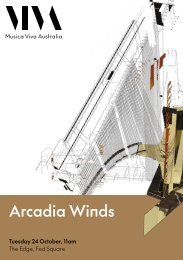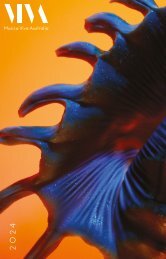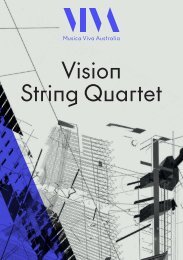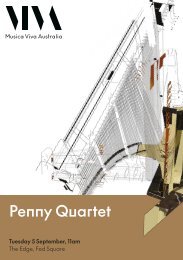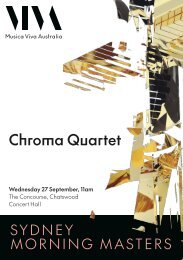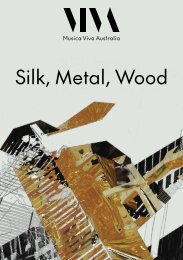You also want an ePaper? Increase the reach of your titles
YUMPU automatically turns print PDFs into web optimized ePapers that Google loves.
<strong>Garrick</strong> <strong>Ohlsson</strong>
2
Musica Viva Australia acknowledges the Traditional Custodians of the many lands on which we meet,<br />
work and live. We pay our respects to their Elders past and present – people who have<br />
sung their songs, danced their dances and told their stories on these lands<br />
for thousands of generations, and who continue to do so.<br />
GARRICK OHLSSON<br />
piano<br />
ADELAIDE<br />
Adelaide Town Hall<br />
Thursday 8 <strong>June</strong>, 7.30pm<br />
• Pre-concert talk: 6.45pm,<br />
Prince Alfred Room<br />
BRISBANE<br />
Conservatorium Theatre,<br />
Griffith University, South Bank<br />
Thursday 1 <strong>June</strong>, 7pm<br />
• Pre-concert talk: 6.15pm, Boardroom,<br />
Qld Conservatorium, Griffith University<br />
• Meet the Artist after the concert<br />
CANBERRA<br />
Llewellyn Hall,<br />
ANU School of Music<br />
Thursday 15 <strong>June</strong>, 7pm<br />
• Pre-concert talk: 6.15pm,<br />
Larry Sitsky Recital Room<br />
• Meet the Artist after the concert<br />
MELBOURNE<br />
Elisabeth Murdoch Hall,<br />
Melbourne Recital Centre<br />
Saturday 3 <strong>June</strong>, 7pm<br />
Recorded for broadcast by ABC Classic<br />
• Pre-concert talk: 6.15pm,<br />
Salzer Suite, Level 2<br />
Tuesday 13 <strong>June</strong>, 7pm<br />
• Pre-concert talk: 6.15pm,<br />
Salzer Suite, Level 2<br />
• Meet the Artist after the concert<br />
NEWCASTLE<br />
City Hall<br />
Saturday 10 <strong>June</strong>, 7.30pm<br />
• Pre-concert talk: 6.45pm,<br />
Mulubinba Room<br />
PERTH<br />
Perth Concert Hall<br />
Monday 19 <strong>June</strong>, 7.30pm<br />
• Pre-concert talk: 6.45pm,<br />
Corner Stage Riverside, Terrace Level<br />
• Meet the Artist after the concert<br />
SYDNEY<br />
City Recital Hall<br />
Monday 5 <strong>June</strong>, 7pm<br />
• Pre-concert talk: 6.15pm,<br />
Function Room, Level 1<br />
• Meet the Artist after the concert,<br />
Concert Hall<br />
Saturday 17 <strong>June</strong>, 2pm<br />
• Pre-concert talk: 1.15pm,<br />
Function Room, Level 1<br />
• CD signing after the concert,<br />
Main Foyer<br />
—<br />
With special thanks to the Producers’ Circle<br />
and Amadeus Society for their support<br />
of the <strong>2023</strong> Concert Season.<br />
01
Hear the Future<br />
ABEO QUARTET | AFFINITY QUARTET | ALBÉNIZ TRIO<br />
BALOURDET QUARTET | TRIO BOHÉMO | TRIO DELYRIA<br />
DIOR QUARTET | TRIO GAIA | MILA QUARTET | TRIO ORELON<br />
TRIO PANTOUM | RISUS QUARTET | TERRA STRING QUARTET | TRIO UNIO<br />
musicaviva.com.au/micmc<br />
Competition Producer<br />
Principal Partner<br />
Strategic Partner<br />
Grand Prize Partner
From the Artistic Director<br />
© Darren Leigh Roberts<br />
In recent correspondence about this and that<br />
with the wonderful young Perth pianist Jude<br />
Holland, we inevitably landed on <strong>Garrick</strong><br />
<strong>Ohlsson</strong>. ‘I went a couple of years ago to hear<br />
him – his Chopin was mesmerising,’ Jude<br />
wrote. Indeed it was – as it was over 50 years<br />
ago when he picked up First Prize in the 1970<br />
Chopin Competition, five years after Martha<br />
Argerich had done the same. Those competition<br />
performances launched a dazzling career that<br />
has defined <strong>Garrick</strong> as one of the great pianists<br />
of the 20th and 21st centuries.<br />
Those who attended <strong>Garrick</strong>’s tour for Musica<br />
Viva Australia in February/March 2020 – ill<br />
winds almost upon us – responded pretty much<br />
as Jude did. We didn’t know then how much<br />
we’d be starved of such artistry in the years to<br />
come, yet even so we recognised the magic in<br />
the air. I really wanted to cauterize those years<br />
of misfortune; bookending them with tours by<br />
<strong>Garrick</strong> seemed the best way of doing so.<br />
I jokingly told <strong>Garrick</strong> that Liszt’s B minor Sonata<br />
was a young man’s game, when he said he’d<br />
like to program it; he quickly raised me one by<br />
saying that he’d also like to program Samuel<br />
Barber’s Piano Sonata, another punishing<br />
mountain to climb. Pairing him with the young<br />
Australian composer Thomas Misson for a new<br />
work commissioned by Stephen Johns in honour<br />
of his wife Michele’s birthday has been the icing<br />
on this rich, exquisite cake!<br />
Paul Kildea<br />
Artistic Director<br />
Musica Viva Australia<br />
03
Brisbane | Canberra | Melbourne (Saturday) | Newcastle | Sydney (Monday)<br />
<strong>Program</strong> 1<br />
Franz SCHUBERT (1797–1828)<br />
Impromptu in C minor, Op. 90, No. 1 (1827)<br />
10 min<br />
Franz LISZT (1811–1886)<br />
Piano Sonata in B minor, S.178 (1853)<br />
30 min<br />
INTERVAL<br />
Thomas MISSON (b 1992)<br />
Convocations (<strong>2023</strong>)<br />
World premiere performances.<br />
Commissioned for Musica Viva Australia by Stephen Johns for his wife, Michele.<br />
10 min<br />
Alexander SCRIABIN (1872–1915)<br />
Étude in C-sharp minor, Op. 2, No. 1 (1887)<br />
Étude in D-flat major, Op. 8, No. 10 (1894)<br />
Étude in C-sharp minor, Op. 42, No. 5 (1903)<br />
Two Poems, Op. 32 (1903)<br />
I Andante cantabile (F-sharp major)<br />
Piano Sonata No. 5, Op. 53 (1907)<br />
3 min<br />
2 min<br />
3 min<br />
4 min<br />
12 min<br />
—<br />
Please ensure that mobile phones are turned to silent before the performance.<br />
Please save photography for the final applause only.<br />
04
Adelaide | Melbourne (Tuesday) | Perth | Sydney (Saturday)<br />
<strong>Program</strong> 2<br />
Claude DEBUSSY (1862–1918)<br />
Suite bergamasque, L. 75 (1905)<br />
I Prélude<br />
II Menuet<br />
III Clair de lune (Moonlight)<br />
IV Passepied<br />
Samuel BARBER (1910–1981)<br />
Piano Sonata in E-flat minor, Op. 26 (1949)<br />
I Allegro energico (Fast and energetic)<br />
II Allegro vivace e leggero (Fast, lively and light)<br />
III Adagio mesto (Slow and sad)<br />
IV Fuga: Allegro con spirito (Fugue: Fast and spirited)<br />
20 min<br />
19 min<br />
INTERVAL<br />
Thomas MISSON (b 1992)<br />
Convocations (<strong>2023</strong>)<br />
World premiere performances.<br />
Commissioned for Musica Viva Australia by Stephen Johns for his wife, Michele.<br />
10 min<br />
Frédéric CHOPIN (1810–1849)<br />
Variations brillantes, Op. 12 (1833)<br />
I Introduction. Allegro maestoso (Fast and majestic)<br />
II Thème. Allegro moderato (Moderately fast)<br />
III Variation 1<br />
IV Variation 2. Scherzo (Light-hearted)<br />
V Variation 3. Lento (Slow)<br />
VI Variation 4. Scherzo vivace (Light-hearted and lively)<br />
Piano Sonata No. 1 in C minor, Op. 4 (1828)<br />
III Larghetto (A little slowly)<br />
Scherzo No. 2 in B-flat minor, Op. 31 (1837)<br />
8 min<br />
4 min<br />
11 min<br />
05
<strong>Program</strong> 1<br />
The death of Beethoven in early 1827 deeply<br />
affected the 30-year-old Franz Schubert,<br />
who himself only had 18 months to live, and<br />
perhaps spurred him to even greater creative<br />
heights. That same year Schubert wrote the<br />
monumental song cycle Winterreise, the<br />
magnificent last three piano sonatas, the two<br />
piano trios and other extraordinary works<br />
including the Impromptus for piano. The<br />
C minor Impromptu is a work of haunting<br />
beauty. The melancholy opening theme is<br />
immediately captivating, its brooding minor<br />
restlessness giving way to a lyrical, more<br />
soothing version of the theme but now in A-flat<br />
major. The transition from minor to major keys<br />
is an important feature of Schubert’s music,<br />
both for harmonic colour and also for the<br />
implied change in emotional inflection. After<br />
a series of variations alternating between<br />
major and minor versions of the themes and<br />
culminating in a powerful climax, the<br />
opening melody returns, but now finally in<br />
C major, signalling a sense of acceptance<br />
and resolution.<br />
Franz Liszt and Franz Schubert could not<br />
have been more different in personality and<br />
in their engagement with society. Schubert<br />
was shy and introverted, kept a small circle<br />
of close friends and rarely ventured out in<br />
public. Liszt, on the other hand, was a highly<br />
charismatic extrovert, a flamboyant showman<br />
who travelled extensively. Nonetheless, Liszt<br />
was strongly influenced by Schubert’s music.<br />
He transcribed dozens of Schubert’s songs for<br />
solo piano and arranged Schubert’s extended<br />
piano work Wanderer Fantasy as a concerto<br />
for piano and orchestra.<br />
Liszt’s Sonata in B minor has some striking<br />
similarities with the Wanderer Fantasy. Both<br />
works are played straight through without a<br />
break yet are internally subdivided into four<br />
movements. Furthermore, in both works, the<br />
musical material is based on themes heard at<br />
the beginning which are transformed or varied<br />
as the piece unfolds, creating a sense of unity<br />
within the larger structure. In the Liszt sonata<br />
four musical ideas form the basis for the whole<br />
work. We hear the first three immediately – a<br />
descending scale, a leaping octave passage<br />
and a low-register gruff theme based on<br />
repeated notes. The fourth, a chorale-like<br />
theme, appears around three minutes in.<br />
Liszt’s transformations and variations of<br />
these ideas is masterly. One of the most<br />
striking occurs in the sonata’s slow movement<br />
where the opening low gruff theme becomes<br />
an elegant and dreamy melody, singing<br />
beautifully in the treble register. Immediately<br />
after this section, the leaping octave theme<br />
serves as the basis for a powerful and<br />
extended fugal passage.<br />
The sonata was not universally well received<br />
at first. Its uncompromising sound world,<br />
musical and technical complexity, and<br />
06
perhaps even its lack of a Romantic title or<br />
programmatic references, set it apart from<br />
much of Liszt’s other piano music for which he<br />
was so celebrated. Nowadays, the sonata is<br />
universally acknowledged as a pinnacle of the<br />
repertoire and revered for its brilliant, at times<br />
exhilarating, piano writing and its captivating<br />
sense of musical journey.<br />
Thomas Misson is a composer, pianist and<br />
music journalist from Hobart. He graduated<br />
from the University of Tasmania with Honours<br />
in Composition under the tutelage of Maria<br />
Grenfell, Russell Gilmour and Don Kay.<br />
Misson’s compositions are inspired by the<br />
extremes of the human condition and its<br />
omnipresent imperfections.<br />
His music was highly commended in the<br />
national Jean Bogen Youth Prize, and has<br />
been heard on ABC Classic and Making<br />
Waves. He has been commissioned by<br />
artists including the Tasmanian Symphony<br />
Orchestra, MATTRA, and the ACO Collective,<br />
as featured on the album Hush 18: Collective<br />
Wisdom. During 2019 he was selected for the<br />
composition stream of the AYO National Music<br />
Camp, and Ensemble Offspring’s Hatched<br />
Academy. An experienced solo pianist and<br />
accompanist, he holds an LMusA (Distinction),<br />
the Nelle Ashdown Memorial Award, and<br />
has toured with Virtuosi Tasmania. When not<br />
composing, Misson maintains a busy schedule<br />
as an accompanist, composition teacher and<br />
music critic for The Mercury.<br />
The composer writes:<br />
In 2021, I was approached by Paul Kildea from<br />
Musica Viva Australia to write a piece for<br />
<strong>Garrick</strong> <strong>Ohlsson</strong> for his <strong>2023</strong> Australian tour.<br />
He would be playing works by Liszt, Barber,<br />
Schubert, Scriabin, and Chopin (of whose<br />
music <strong>Garrick</strong> is a famous interpreter).<br />
While researching and reflecting on how my<br />
creative voice could complement the program,<br />
I stumbled on a description of <strong>Garrick</strong>’s<br />
playing that described him as possessing a<br />
‘calmly commanding presence’.<br />
I decided I would channel a piece by Liszt<br />
which evokes the same descriptors for me,<br />
Sposalizio from Années de pèlerinage (Years<br />
of Pilgrimage). In this work, Liszt describes<br />
Raphael’s high-Renaissance painting<br />
Sposalizio (The Marriage of the Virgin) in<br />
musical form. Though some of the motivic<br />
and structural scaffolding draws on the Liszt,<br />
conceptually and stylistically the piece has<br />
come to resemble something more pluralistic<br />
than a marriage. Convocations combines<br />
the unlikely and disparate elements of the<br />
Romantic piano giants, modernist styles, an<br />
Australian tour, a Tasmanian composer, and<br />
an American concert pianist in a congregation<br />
that aims to give life to a spiritual soundworld.<br />
THOMAS MISSON © <strong>2023</strong><br />
Alexander Scriabin was originally hailed<br />
as the Russian Chopin. In his collections of<br />
preludes, études, mazurkas and nocturnes for<br />
piano, he paid homage to Chopin’s legacy<br />
both in genre and in his richly Romantic,<br />
voluptuous musical style. The three études<br />
(studies) we will hear in this performance<br />
certainly owe a debt to Chopin’s groundbreaking<br />
studies as well as those of Liszt.<br />
The simplicity of the beguiling melody in the<br />
first C-sharp minor study gives way to some<br />
fiendishly difficult piano writing in the following<br />
two works.<br />
07
in Rome but this was an important time for<br />
the composer in gaining confidence with his<br />
emerging unique musical voice. He had also<br />
recently discovered the music of Wagner and<br />
heard for the first time Javanese Gamelan,<br />
and both experiences were to influence his<br />
compositional development.<br />
In his Two Poems, Scriabin moves away from<br />
the Romantic gestures of the studies, creating a<br />
more forward-looking exploration of melody,<br />
texture and harmony which would evolve into<br />
his mature style. Also around this time, we see<br />
the development of his aesthetic to embrace a<br />
mystical, transcendental conception of music.<br />
While the first Poem is languid, rhythmically<br />
fluid and melodically focused, the second is<br />
an explosive, rhythmically driven piece full of<br />
extrovert energy.<br />
The Piano Sonata No. 5, written four years<br />
later, takes these extreme moods even further.<br />
This is an intensely volatile piece, languid and<br />
dreamy one moment, then suddenly frenzied<br />
and excited. Scriabin often juxtaposes these<br />
states without preparation, resulting in a form<br />
that feels episodic rather than organic but<br />
never ceases to surprise and excite.<br />
ANNOTATIONS BY MARK COUGHLAN © <strong>2023</strong><br />
Debussy began writing the Suite bergamasque<br />
around 1890 although it was not until 1905<br />
that it was revised and published. The work<br />
pays homage in part to the Baroque keyboard<br />
music that Debussy greatly admired, especially<br />
that of Couperin. The opening Prélude has an<br />
improvisatory quality alternating between<br />
bold and elegant. The following Menuet<br />
has a slightly wistful character, playful and<br />
delicate, its vigorous dance rhythms somewhat<br />
restrained. Clair de lune is a work of ethereal<br />
beauty and one of the most celebrated of all<br />
piano pieces with its ravishing textures and<br />
seductive harmonies. The final Passepied<br />
bubbles along to the gently driving left-hand<br />
rhythm, drawing this charming set to a close.<br />
<strong>Program</strong> 2<br />
In the late 1880s Claude Debussy returned to<br />
Paris having spent a couple of unfulfilling years<br />
at the Villa Medici in Rome, a residency that<br />
resulted from his winning the prestigious Prix<br />
de Rome in 1884. He was disappointed with the<br />
company, the food and the accommodation<br />
Samuel Barber is regarded as one of<br />
America’s finest composers. Born in 1910 into<br />
a musical family, he studied composition,<br />
voice and piano and for a number of years<br />
was a student at the celebrated Curtis Institute<br />
in Philadelphia. He decided early on that<br />
music would be his chosen career, writing to<br />
his mother at the age of nine to declare his<br />
intention to become a composer and asking<br />
her not to force him to play football. By the age<br />
of seven he had written his first piano piece,<br />
08
at ten his first operetta and he was appointed<br />
church organist when he was 12. Much of<br />
Barber’s music conveys a sense of post-<br />
Romantic lyricism, his gift for singing informing<br />
an often expressive melodic style.<br />
Barber’s Piano Sonata has an extraordinary<br />
pedigree, being commissioned by two of the<br />
great American song writers, Irving Berlin<br />
and Richard Rodgers, and premiered by the<br />
legendary pianist Vladimir Horowitz. This<br />
monumental work shows the more modern<br />
dimension of Barber’s writing, employing<br />
techniques such as 12-tone rows – arranging<br />
all of the notes within an octave (both the black<br />
and the white notes, on a piano keyboard)<br />
into a fixed order – and bitonality. In the<br />
first movement the writing is often gritty and<br />
angular with passages of thunderous virtuosity<br />
contrasted with moments of wistful lyricism.<br />
The delightful second movement creates<br />
a sense of lighthearted playfulness with its<br />
sparkling textures, alternating beat patterns<br />
and unexpected turns. By contrast, the slow<br />
third movement is a concentrated, somewhat<br />
mournful piece of sustained intensity. Barber’s<br />
interest in Bach’s keyboard music seems to be<br />
an influence in this movement, as well as in<br />
the finale which begins in a highly-charged,<br />
fugal style with virtuosic toccata-like writing<br />
throughout.<br />
For Thomas Misson’s Convocations,<br />
see page 07.<br />
From the moment he arrived in Paris in 1831<br />
Frédéric Chopin became a regular at the<br />
opera. He was particularly drawn to the<br />
operas of Rossini, Bellini and Donizetti, and<br />
much of his melodic writing reflects their<br />
ornamented lyricism. In May 1833 Chopin<br />
attended a performance of Ferdinand Hérold’s<br />
opera Ludovic. As was common practice in the<br />
Parisian salons, he subsequently wrote a set of<br />
Variations brillantes on one of the arias. After<br />
an introduction and simple statement of the<br />
lilting theme, there is a series of variations: the<br />
first elegantly flowing, then a jaunty dance, a<br />
lyrical variation in the style of a nocturne and<br />
a bravura scherzo that brings the piece to an<br />
exciting conclusion.<br />
Chopin’s first piano sonata was written while<br />
he was still a student in Warsaw, and was not<br />
published during the composer’s lifetime. The<br />
serene Larghetto movement foreshadows his<br />
enormous success writing nocturnes. The piece<br />
is written with five beats per bar, creating for<br />
the listener a subtle disorientation around<br />
the phrasing, but this was not an experiment<br />
Chopin ever repeated.<br />
In contrast to these rarely heard works, the<br />
Scherzo No. 2 is one of Chopin’s most popular<br />
compositions. It is full of drama and pianistic<br />
flair with striking contrasts between explosive<br />
virtuosity, long lyrical melodies and a quietly<br />
elegiac middle section. The excitement builds<br />
with gripping intensity throughout the coda,<br />
propelling the music towards a thrilling<br />
conclusion.<br />
ANNOTATIONS BY MARK COUGHLAN © <strong>2023</strong><br />
09
© Pier Andrea Morolli<br />
<strong>Garrick</strong> <strong>Ohlsson</strong><br />
<strong>Garrick</strong> <strong>Ohlsson</strong> is acclaimed worldwide as<br />
a musician of magisterial interpretive and<br />
technical prowess. Although long regarded<br />
as one of the world’s leading exponents of the<br />
music of Frédéric Chopin, he commands an<br />
enormous repertoire which ranges over the<br />
entire piano literature. A student of the late<br />
Claudio Arrau, <strong>Garrick</strong> <strong>Ohlsson</strong> has come to<br />
be noted for his masterly performances of the<br />
works of Mozart, Beethoven and Schubert, as<br />
well as the Romantic repertoire. To date he<br />
has at his command more than 80 concertos,<br />
ranging from Haydn and Mozart to works<br />
of the 21st century, many commissioned<br />
for him. In the 2018/19 season he launched<br />
an ambitious project spread over multiple<br />
seasons exploring the complete solo piano<br />
works of Brahms in four programs to be<br />
heard in New York, San Francisco, Montreal,<br />
Los Angeles, London and a number of cities<br />
across North America.<br />
A frequent guest with orchestras in New<br />
Zealand and Australia, <strong>Garrick</strong> <strong>Ohlsson</strong><br />
accomplished a seven-city recital tour<br />
across Australia just prior to the closure of<br />
the concert world due to COVID-19. Since<br />
that time and as a faculty member of San<br />
Francisco Conservatory of Music he kept<br />
music alive for a number of organisations<br />
with live or recorded recital streams. Since the<br />
re-opening of concert activity in 2021 he has<br />
appeared with the orchestras of Indianapolis,<br />
Atlanta, Dallas, Seattle, Toronto and<br />
Cleveland, and in recital in San Francisco,<br />
Los Angeles, Houston, at the Ravinia and<br />
Tanglewood summer festivals and on a<br />
US tour with colleague Kirill Gerstein. The<br />
2022/23 season includes appearances with<br />
orchestras in Boston, Detroit, Minneapolis,<br />
San Diego, Spain, Poland and Czech<br />
Republic.<br />
10
Brahms piano variations, the Granados<br />
Goyescas, music of Charles Tomlinson<br />
Griffes, Scriabin’s complete Poèmes,<br />
Smetana’s Czech Dances and études by<br />
Debussy, Bartók and Prokofiev; for Bridge<br />
Records, the complete Scriabin sonatas,<br />
Close Connections – a recital of 20th-century<br />
works, and two CDs of works by Liszt; live<br />
recordings of both Brahms concertos with<br />
the Melbourne Symphony Orchestra and<br />
Tchaikovsky’s Second Piano Concerto with<br />
the Sydney Symphony Orchestra; and<br />
Dvořák’s Piano Concerto, featured in the<br />
Czech Philharmonic’s complete set of the<br />
composer’s symphonies and concertos.<br />
In recognition of the Chopin bicentenary<br />
in 2010, <strong>Garrick</strong> <strong>Ohlsson</strong> was featured<br />
in the documentary The Art of Chopin,<br />
co-produced by Polish, French, British and<br />
Chinese television stations.<br />
An avid chamber musician, <strong>Garrick</strong> <strong>Ohlsson</strong><br />
has collaborated with the Cleveland,<br />
Emerson, Tokyo and Takács string quartets<br />
and began the 2022/23 season with a US tour<br />
with Poland’s Apollon Musagète Quartet.<br />
Passionate about singing and singers,<br />
<strong>Garrick</strong> <strong>Ohlsson</strong> has appeared in recital with<br />
such legendary artists as Magda Olivero,<br />
Jessye Norman and Ewa Podleś.<br />
<strong>Garrick</strong> <strong>Ohlsson</strong> can be heard on the<br />
Arabesque, RCA Victor Red Seal, Angel,<br />
BMG, Delos, Hänssler, Nonesuch, Telarc,<br />
Hyperion and Virgin Classics labels. His<br />
ten-disc set of the complete Beethoven<br />
sonatas, for Bridge Records, has garnered<br />
critical acclaim, including a GRAMMY® for<br />
Vol. 3. Other highlights in his discography<br />
include Rachmaninoff’s Concerto No. 3<br />
with the Atlanta Symphony Orchestra and<br />
Robert Spano; for Hyperion, a 16-disc set<br />
of the complete works of Chopin, all the<br />
A native of White Plains, NY, <strong>Garrick</strong><br />
<strong>Ohlsson</strong> began his piano studies at the age<br />
of eight at the Westchester Conservatory of<br />
Music; at 13 he entered The Juilliard School,<br />
in New York City. His musical development<br />
has been influenced in completely different<br />
ways by a succession of distinguished<br />
teachers, most notably Claudio Arrau, Olga<br />
Barabini, Tom Lishman, Sascha Gorodnitzki,<br />
Rosina Lhévinne and Irma Wolpe. Although<br />
he won First Prizes at the 1966 Busoni<br />
Competition in Italy and the 1968 Montréal<br />
Piano Competition, it was his 1970 triumph<br />
at the International Chopin Competition in<br />
Warsaw, where he won the Gold Medal – he<br />
remains the single American to have done<br />
so – that brought him worldwide recognition<br />
as one of the finest pianists of his generation.<br />
Since then he has made nearly a dozen<br />
tours of Poland, where he retains immense<br />
personal popularity. <strong>Garrick</strong> <strong>Ohlsson</strong> was<br />
awarded the Avery Fisher Prize in 1994 and<br />
received the 1998 University Musical Society<br />
Distinguished Artist Award in Ann Arbor, MI.<br />
He was the 2014 recipient of the Jean Gimbel<br />
Lane Prize in Piano Performance from the<br />
Northwestern University Bienen School of<br />
Music, and in August 2018 the Polish Deputy<br />
Culture Minister awarded him the Gloria<br />
Artis Gold Medal for cultural merit. He is a<br />
Steinway Artist and makes his home in San<br />
Francisco.<br />
11
Meet the Artist<br />
BY PHIL BROWN<br />
He’s here to play but let’s hope we also get<br />
to hear some words from <strong>Garrick</strong> <strong>Ohlsson</strong>.<br />
The loquacious American pianist who is<br />
sometimes known as ‘The Chopin Guy’ (for<br />
obvious reasons) likes to chat to his audience,<br />
sometimes about Chopin, sometimes about<br />
Scriabin (both of whom feature strongly in this<br />
Music Viva Australia tour program) or other<br />
composers and music in general.<br />
<strong>Ohlsson</strong> is an erudite and entertaining man<br />
who loves to background his performances. In<br />
particular, hearing him talk about Alexander<br />
Scriabin (1872–1915), the enigmatic Russian<br />
pianist, is a treat. <strong>Garrick</strong> is fascinated with<br />
Scriabin, whom he describes as ‘canonical yet<br />
relatively rarely heard because all his music is<br />
for piano solo’.<br />
‘I like to talk about Scriabin because very often<br />
the concert-going audience doesn’t have a<br />
handle on who he is,’ <strong>Garrick</strong> offers. ‘He starts<br />
out as a Chopin obsessive but by the end of his<br />
life he is very much an individual. I love talking<br />
to the audience about him because he is so out<br />
there. He was also obsessed with Chopin as a<br />
child. He was this neurasthenic, hypersensitive<br />
teenager who slept with Chopin’s music under<br />
his pillow.’<br />
Scriabin, he explains, is ‘one of the strangest<br />
and most interesting composers’. He was also<br />
a philosopher and even a bit of a mystic with<br />
an interest in theosophy, a man who ‘wanted<br />
to save the world through his art’.<br />
Scriabin’s powerful, impressionistic music is an<br />
ideal match for <strong>Garrick</strong> <strong>Ohlsson</strong>’s authoritative<br />
playing. He’s a physically imposing figure<br />
whose playing style has been described as<br />
projecting an ‘Olympian serenity’.<br />
He adores Barber and Schubert, Debussy<br />
and Liszt too, choosing this Australian tour<br />
for his first performance in many years of the<br />
latter’s Sonata in B minor. His program also<br />
features a new work commissioned through<br />
Musica Viva Australia for <strong>Garrick</strong> to premiere:<br />
Convocations, by the Australian composer<br />
Thomas Misson, a musician from Hobart. It<br />
was commissioned by Musica Viva Australia<br />
donor Stephen Johns as a birthday gift for his<br />
wife, Michele, and <strong>Garrick</strong> enjoys the fact that<br />
playing the piece will be a rather unique way<br />
of saying ‘Happy Birthday’.<br />
Of course, there will be some Chopin in the<br />
program – how could there not be?<br />
The foundation of <strong>Garrick</strong>’s long and successful<br />
career is Chopin’s music and he has that in<br />
common with Scriabin.<br />
<strong>Garrick</strong> <strong>Ohlsson</strong> burst onto the international<br />
scene in 1970 when, at the age of 22, he won<br />
first prize in the International Chopin Piano<br />
Competition, the first American to have done<br />
so. In an interview with Calvin Dotsey for the<br />
Houston Symphony, <strong>Garrick</strong> acknowledged<br />
the effect the prize had on his life: ‘It really<br />
put my name on the front page of the<br />
world’s major newspapers. So in a way the<br />
competition and Chopin’s music really were the<br />
decisive turning point in my having a career.<br />
It gave me my first step everywhere and<br />
Chopin’s music has been with me my whole<br />
life. I’ve played so much Chopin. In fact, I’ve<br />
recorded it all.’<br />
The San Francisco-based musician describes<br />
himself as ‘a wandering minstrel’ who says<br />
travel is ‘boring and tedious. But I’ve become<br />
good at it,’ he says.<br />
12
<strong>Garrick</strong> <strong>Ohlsson</strong> has visited Australia on a<br />
number of occasions. ‘I guess you could say<br />
that I’m a semi-regular visitor,’ he says. ‘Last<br />
time I was there was in 2020 just after all the<br />
terrible bushfires.’<br />
He believes that music is ‘a tonic and a balm<br />
for the soul in all aspects. Music makes you feel<br />
things that almost bypass consciousness.’ That<br />
sounds like something Scriabin might have<br />
said or at least agreed with. But as much as he<br />
likes to talk about music and the composers<br />
he loves, <strong>Garrick</strong> <strong>Ohlsson</strong> doesn’t want to<br />
explain away the magical elements of classical<br />
music. The mystique should remain intact, he<br />
suggests.<br />
To that end he tells a favourite story about<br />
a woman who, hearing the young and then<br />
relatively unknown Beethoven play, was a bit<br />
mystified by this new music.<br />
‘She asked him what the piece he had just<br />
played meant,’ <strong>Ohlsson</strong> says, and there was<br />
only one way for Beethoven to answer. ‘He sat<br />
down and played it again.’ Point taken.<br />
‘A tonic and<br />
a balm for the soul’<br />
13
BREAK<br />
OUT<br />
YAMAHA<br />
P I A N O<br />
TEACHER<br />
AWARD<br />
Celebrating<br />
Australian Piano<br />
Teachers<br />
The Yamaha Breakout Award is a national<br />
award designed to celebrate the work that<br />
piano teachers do in the community. It<br />
supports Yamaha’s own education advocacy<br />
program Off to a Great Start and their ambition<br />
to engage more people in music-making.<br />
REGISTER<br />
YOUR<br />
INTEREST<br />
FOR THE <strong>2023</strong><br />
AWARD<br />
Each year, Yamaha reach out to the community<br />
of piano teachers who strive to advance<br />
their own professional development for the<br />
benefit of their students. Teachers who are<br />
committed and passionate about the value of<br />
music education and the impact it can have in<br />
students’ lives.
cullenwines.com.au<br />
CELEBRATING MORE THAN<br />
35 YEARS OF PIANO EXCELLENCE<br />
PROUD PARTNER<br />
&<br />
PIANO TECHNICIANS<br />
OF CHOICE<br />
themeandvariations.com.au<br />
SALES | TUNING | REPAIRS | RESTORATIONS | HIRE | TUITION
For over 40 years Musica Viva Australia In Schools has brought<br />
diverse ensembles to generations of children in metropolitan and<br />
regional areas in all states and territories, and remote locations such<br />
as Christmas Island off the coast of Western Australia and APY Lands<br />
in South Australia. Complementing this performance program are<br />
our online curriculum-aligned digital resources and Professional<br />
Development programs to support teachers with the tools and<br />
confidence to enjoy music in their classrooms all year round.<br />
This has been possible thanks to the support of our donors<br />
whose insight and generosity have enabled children of all regions<br />
and circumstances to discover the power of live music.<br />
For information about giving to our education program,<br />
please contact Caroline Davis, our Individual Giving Manager:<br />
cdavis@musicaviva.com.au | 0421 375 358<br />
For more information about Musica Viva Australia’s<br />
comprehensive education program, please visit<br />
musicaviva.com.au/education
Patrons<br />
CUSTODIANS<br />
ACT Margaret Brennan, Clive & Lynlea Rodger,<br />
Ruth Weaver, Anonymous (4)<br />
NSW Catherine Brown-Watt PSM & Derek Watt, Jennifer<br />
Bott AO, Lloyd & Mary Jo Capps AM, Andrew & Felicity<br />
Corkill, Peter Cudlipp, Liz Gee, Suzanne Gleeson, David<br />
& Christine Hartgill, Annie Hawker, Elaine Lindsay, Trevor<br />
Noffke, Dr David Schwartz, Ruth Spence-Stone, Mary<br />
Vallentine AO, Deirdre Nagle Whitford, Richard Wilkins,<br />
Kim Williams AM, Megan & Bill Williamson, Ray Wilson<br />
OAM, Anonymous (12)<br />
QLD Anonymous (2)<br />
SA Monica Hanusiak-Klavins & Martin Klavins,<br />
Anonymous (4)<br />
TAS<br />
Kim Paterson QC, Anonymous<br />
VIC Elizabeth & Anthony Brookes, Julian Burnside AO<br />
QC, Ms Helen Dick, Robert Gibbs & Tony Wildman, Helen<br />
Vorrath, Anonymous (8)<br />
WA Graham Lovelock, Anonymous (4)<br />
LEGACY DONORS<br />
ACT<br />
The late Geoffrey Brennan<br />
NSW The late Charles Berg, The late Stephen Center,<br />
The late Janette Hamilton, The late Dr. Ralph Hockin in<br />
memory of Mabel Hockin, The late Kenneth W Tribe AC<br />
QLD<br />
The late Steven Kinston<br />
SA The late Edith Dubsky, The late John Lane Koch,<br />
The late Lesley Lynn<br />
VIC In memory of Anita Morawetz, The family of<br />
the late Paul Morawetz, The late Dr G D Watson<br />
WA<br />
Anonymous<br />
CONCERT CHAMPIONS<br />
The mainstage concerts of our <strong>2023</strong> Season are brought<br />
to life thanks to the generosity of our Concert Champions<br />
around the country.<br />
Adelaide Helen Bennetts & Tim Lloyd, The late Lesley Lynn,<br />
Dr Susan Marsden & Michael Szwarcbord, Leonie Schmidt &<br />
Michael Davis, Anonymous (2)<br />
Brisbane Ian & Cass George, Andrea & Malcolm Hall-Brown,<br />
Andrew & Kate Lister, Barry & Diana Moore, Anonymous (2)<br />
Canberra Andrew Blanckensee Music Lover, Sue & Ray<br />
Edmondson, Malcolm Gillies & David Pear in memory<br />
of Stewart Gillies, Humphries Family Trust, Claudia<br />
Hyles, Margaret Lovell & Grant Webeck, Ruth Weaver &<br />
Anonymous, Dr Suzanne Packer, Sue Terry & Len Whyte,<br />
Anonymous<br />
Melbourne Alexandra Clemens & Bibi Aickin, Penelope<br />
Hughes, Peter Lovell, The Morawetz Family in memory of<br />
Paul Morawetz, Dr John Tang, Dr Michael Troy, Ray Turner<br />
& Jennifer Seabrook, The late Dr G D Watson,<br />
Dr Victor Wayne & Dr Karen Wayne OAM, Igor Zambelli<br />
Newcastle Judith Bennett, Gabrielle Bookallil,<br />
Megan & Bill Williamson<br />
Perth Dr Robert Larbalestier AO, Deborah Lehmann AO<br />
& Michael Alpers AO, Prichard Panizza Family (2),<br />
For Stephanie Quinlan (2), Valerie & Michael Wishart<br />
Sydney Judith Bennett, Patricia Crummer, Pam Cudlipp,<br />
Dr Jennifer Donald & Mr Stephen Burford, Charles Graham<br />
– in acknowledgement of his piano teacher, Sana Chia,<br />
Katherine & Reg Grinberg, Anthony Strachan, Tribe Family,<br />
Kay Vernon, Kim Williams AM & Catherine Dovey (2)<br />
PRODUCERS’ CIRCLE<br />
Darin Cooper Foundation, Peter Griffin AM & Terry Swann<br />
ENSEMBLE PATRONS<br />
Our artistic vision for <strong>2023</strong> is made possible thanks to<br />
the extraordinary generosity of our Ensemble Patrons,<br />
each of whom supports the presentation of an entire<br />
national tour for our <strong>2023</strong> Season.<br />
Ian & Caroline Frazer (Karin Schaupp & Flinders Quartet)<br />
Ian Dickson AM & Reg Holloway and Anonymous<br />
(The Cage Project)<br />
Stephen & Michele Johns & Anonymous (Chopin’s Piano)<br />
Eleanore Goodridge OAM (Wildschut & Brauss)<br />
AMADEUS SOCIETY<br />
Tony Berg AM & Carol Berg, Marc Besen AC & Eva Besen<br />
AO dec., Ms Jan Bowen AM, Tom Breen & Rachael Kohn AO,<br />
Dr Di Bresciani OAM, Dr Helen Ferguson, Ms Annabella<br />
Fletcher, Dr Annette Gero, Katherine & Reg Grinberg,<br />
Jennifer Hershon & Russell Black, Penelope Hughes,<br />
Michael & Frédérique Katz, Ruth Magid & Bob Magid OAM,<br />
Dr Hadia Mukhtar, Prof. John Rickard, Philip Robinson,<br />
Andrew Rosenberg, Ray Wilson OAM<br />
17
MASTERCLASSES<br />
GIVING CIRCLE<br />
The Masterclasses Giving Circle is a group of generous<br />
donors whose collective support will enable the artistic<br />
development of the next generation of Australian<br />
chamber musicians.<br />
Nicholas Callinan AO & Elizabeth Callinan, Caroline &<br />
Robert Clemente, Patricia H. Reid Endowment Fund,<br />
Andrew Sisson AO & Tracey Sisson, Mick and Margaret<br />
Toller, Anonymous (1)<br />
COMMISSIONS<br />
Musica Viva Australia is proud to support the creation<br />
of new Australian works through The Ken Tribe Fund<br />
for Australian Composition and The Hildegard Project.<br />
We are grateful to the following individuals and<br />
collectives for their generous support of this work:<br />
In loving memory of Jennifer Bates, Christine Bollen &<br />
Friends, The Barry Jones Birthday Commission,<br />
DR & KM Magarey, Naomi Milgrom Foundation &<br />
Ian Dickson AM & Reg Holloway, Playking Foundation,<br />
Tribe Family in honour of Doug Tribe’s 75th Birthday,<br />
Adelaide Commissioning Circle, Perth Commissioning Circle<br />
The Barry Jones Birthday Commission ($500+)<br />
Steve Bracks AC & Terry Bracks AM, Dr George Deutsch<br />
OAM & Kathy Deutsch, Carrillo Gantner, Professor Margaret<br />
Gardner AC & Professor Glyn Davis AC, Naomi & George<br />
Golvan QC, Hon David Harper AM, Ellen Koshland & James<br />
McCaughey, Miles Lewis, Julie & Ian Macphee, Barry McGaw,<br />
Jeannette McHugh, Fiona McLeod AO SC, Peter & Ruth<br />
McMullin, peckvonhartel architects, Ralph & Ruth Renard,<br />
Anne & Robert Richter QC, Gianna Rosica, Joy Selby Smith,<br />
Smith Family, Maureen & Tony Wheeler, Lyn Williams,<br />
Dr Robyn Williams AO, Bob, Robyn, Annie & Nick,<br />
Anonymous (3)<br />
MAJOR GIFTS<br />
$100,000+<br />
NSW The Berg Family Foundation,<br />
Patricia H. Reid Endowment Fund, Anonymous<br />
$50,000–$99,999<br />
ACT<br />
Marion & Michael Newman<br />
NSW J A Donald Family, Katherine & Reg Grinberg,<br />
Tom & Elisabeth Karplus<br />
$20,000–$49,999<br />
NSW Tom Breen & Rachael Kohn AO,<br />
Michael & Frédérique Katz, Vicki Olsson<br />
QLD<br />
Ian & Caroline Frazer, Andrea & Malcolm Hall-Brown<br />
VIC The Morawetz Family in memory of Paul Morawetz,<br />
Anonymous<br />
WA<br />
Anonymous<br />
$10,000–$19,999<br />
ACT<br />
R & V Hillman, Anonymous<br />
NSW Gardos Family, Gresham Partners, Hilmer Family<br />
Endowment, Anthony Strachan, Jo Strutt, Ray Wilson OAM<br />
QLD<br />
SA<br />
Anonymous<br />
Stoneglen Foundation, Anonymous<br />
VIC Roger Druce & Jane Bentley, Peter Griffin AM<br />
& Terry Swann, Monica Lim & Konfir Kabo, Peter Lovell,<br />
In Memory of Dr Ian Marks, Mercer Family Foundation,<br />
Marjorie Nicholas OAM<br />
WA Team Legacy, Deborah Lehmann AO<br />
& Michael Alpers AO<br />
$5,000–$9,999<br />
ACT Goodwin Crace Concertgoers, Craig Reynolds,<br />
Sue Terry & Len Whyte, Anonymous<br />
NSW Christine Bishop, Patricia Crummer,<br />
Sarah & Tony Falzarano, Mrs W G Keighley, Hywel Sims,<br />
David & Carole Singer, Diane Sturrock, Kim Williams AM<br />
& Catherine Dovey<br />
SA<br />
Aldridge Family Endowment, Anonymous<br />
VIC In memory of Kate Boyce, Dr Di Bresciani OAM<br />
& Lino Bresciani, William J Forrest AM, Doug Hooley,<br />
Andrew Johnston, Joy Selby Smith, Greg Shalit &<br />
Miriam Faine, Musica Viva Australia Victorian Committee<br />
MICMC Prize, Anonymous<br />
WA Zoe Lenard & Hamish Milne, Anonymous (2)<br />
18
ANNUAL GIFTS<br />
$2,500–$4,999<br />
ACT Kristin van Brunschot & John Holliday,<br />
Dr Andrew Singer, Anonymous<br />
NSW ADFAS Newcastle, Penny Beran, Susan Burns<br />
QLD<br />
SA<br />
Greyhound Australia<br />
DJ & EM Bleby<br />
VIC Jan Begg, Alastair & Sue Campbell,<br />
Anne Frankenberg & Adrian McEniery,<br />
Lyndsey & Peter Hawkins, Ralph & Ruth Renard,<br />
Maria Sola, Igor Zambelli<br />
WA<br />
Ros Kesteven, Mrs Morrell, Anonymous<br />
$1,000–$2,499<br />
ACT Andrew Blanckensee, The Breen/Dullo Family,<br />
Odin Bohr & Anna Smet, Dudley & Helen Creagh,<br />
Martin Dolan, Liz & Alex Furman, Malcolm Gillies AM,<br />
Kingsley Herbert, Margaret & Peter Janssens,<br />
Margaret Oates, S Packer, Clive & Lynlea Rodger,<br />
Hannah Semler, Anonymous (3)<br />
NSW Judith Allen, David & Rae Allen, Maia Ambegaokar<br />
& Joshua Bishop, Stephen Booth, Jennifer Bott AO &<br />
Harley Harwood, Vicki Brooke, Neil Burns, Hugh and Hilary<br />
Cairns, Hon J C Campbell QC & Mrs Campbell, Lloyd &<br />
Mary Jo Capps AM, Opus 109 Sub-fund, Community Impact<br />
Foundation, Robin & Wendy Cumming, Thomas Dent,<br />
Nancy Fox AM & Bruce Arnold, John & Irene Garran,<br />
Charles & Wallis Graham, H2 Cairns Foundation, Annie<br />
Hawker, Robert & Lindy Henderson, Lybus Hillman,<br />
Dr Ailsa Hocking & Dr Bernard Williams,<br />
Dorothy Hoddinott AO, Catharine & Robert Kench,<br />
Kevin & Deidre McCann, DR & KM Magarey, Arthur &<br />
Elfreda Marshall, Dr Dennis Mather & John Studdert,<br />
Mora Maxwell, Michael & Janet Neustein, Paul O’Donnell,<br />
Laurie Orchard, Ms Vivienne Sharpe, Dr Robyn Smiles,<br />
Tom & Dalia Stanley, Geoff Stearn, Richard & Beverley<br />
Taperell, Graham & Judy Tribe, John & Flora Weickhardt,<br />
Richard Wilkins, Megan & Bill Williamson, Anonymous (4)<br />
QLD George Booker & Denise Bond, Prof. Paul & Ann<br />
Crook, Robin Harvey, Lynn & John Kelly, Jocelyn Luck,<br />
Barry & Diana Moore, Keith Moore, Debra & Patrick Mullins,<br />
Barbara Williams & Jankees van der Have, Anonymous (2)<br />
SA Ivan & Joan Blanchard, Richard Blomfield, Max &<br />
Ionie Brennan, Joan Lyons, Fiona MacLachlan OAM,<br />
Dr Leo Mahar, Geoff & Sorayya Martin, Ann & David<br />
Matison, Diane Myers, Anne Sutcliffe, Anonymous<br />
TAS<br />
Dianne O’Toole<br />
Adrian Nye, Resonance Fund – Michael Cowen & Sharon<br />
Nathani, Murray Sandland, Marshall Segan & Ylana Perlov<br />
in memory of his late parents, Gary Singer & Geoffrey<br />
Smith, Darren Taylor & Kent Stringer, Wendy R. Taylor,<br />
Ray Turner & Jennifer Seabrook, Dr Victor Wayne &<br />
Dr Karen Wayne OAM, Mark & Anna Yates, Anonymous (2)<br />
WA David & Minnette Ambrose, Dr S Cherian,<br />
Michael & Wendy Davis, In memory of Raymond Dudley,<br />
Dr Penny Herbert in memory of Dunstan Herbert,<br />
Ms Helen Hollingshead, Anne Last & Steve Scudamore,<br />
Hugh & Margaret Lydon, Olivier David & Dr Bennie Ng,<br />
Marian Magee & David Castillo, John Overton,<br />
Margaret & Roger Seares, Robyn Tamke, Anonymous (4)<br />
$500–$999<br />
ACT Christopher Clarke, Peter Cumines, Susan<br />
Edmondson, Jill Fleming, Claudia Hyles OAM,<br />
Margaret Millard, Helen Rankin, Dr Paul & Dr Lel<br />
Whitbread, Anonymous (2)<br />
NSW Denise Braggett, Christopher & Margaret Burrell,<br />
Robert Cahill and Anne Cahill OAM, Lucia Cascone,<br />
Trish & John Curotta, Dr Arno Enno & Dr Anna Enno,<br />
Anthony Gregg, The Harvey Family, Roland &<br />
Margaret Hicks, David & Sarah Howell, Alicia Howlett, In<br />
honour of Michael Katz, Cynthia Kaye, KP Kemp, Mathilde<br />
Kearny-Kibble, Dr Colin MacArthur, Robert McDougall,<br />
Ian & Pam McGaw, Frances Muecke, Kim & Margie Ostinga,<br />
Dr John Rogers, Penny Rogers, Peter & Heather Roland,<br />
Professor Lynne Selwood, Kathie & Reg Grinberg - In<br />
honour of Dalia Stanley’s birthday, Andrew Wells AM,<br />
Anonymous (8)<br />
QLD Geoffrey Beames, Janet Franklin, Timothy Matthies<br />
& Chris Bonnily<br />
SA Zoë Cobden-Jewitt & Peter Jewitt, Daniel & Susan<br />
Hains, Elizabeth Ho OAM, in honour of the late Tom Steel,<br />
Dr Iwan Jensen, Helga Linnert & Douglas Ransom, Julie<br />
Mencel & Michael McKay, Tony Seymour, Anonymous (5)<br />
TAS<br />
Anonymous<br />
VIC David Bernshaw & Caroline Isakow, Pam Caldwell,<br />
John & Mandy Collins, John & Chris Collingwood,<br />
Mary-Jane Gething, John & Margaret Harrison,<br />
Eda Ritchie AM, Maureen Turner, Lyn Williams,<br />
Anonymous (5)<br />
WA Jennifer Butement, Joan Carney, Fred & Angela<br />
Chaney, Rachel & Bruce Craven, Helen Dwyer,<br />
Dr Barry Green, Paula Nathan AO & Yvonne Patterson,<br />
Lindsay & Suzanne Silbert, Father Richard Smith,<br />
Ruth Stratton, Christopher Tyler, Anonymous (5)<br />
VIC Joanna Baevski, Russ & Jacqui Bate, Marlyn Bancroft,<br />
Alison & John Cameron, Alex & Elizabeth Chernov,<br />
Lord Ebury, Dr Glenys & Dr Alan French, Virginia Henry,<br />
Helen Imber, Angela Kayser, Angela & Richard Kirsner,<br />
Angela Li, Janet McDonald, Ruth McNair AM & Rhonda<br />
Brown in memory of Patricia Begg & David McNair, <strong>June</strong> K<br />
Marks, Christopher Menz & Peter Rose, Traudl Moon OAM,<br />
19
Concert Partners<br />
Perth Concert Series Sydney Morning Masters Series Musica Viva Australia at The Edge Series<br />
Commissioning Partner (The Cage Project)<br />
Rehearsal Partner (The Cage Project)<br />
Project Partner (The Cage Project)<br />
Legal<br />
Chartered Accountants<br />
Piano & Tuning<br />
Media Partner Wine Partner act, nsw, qld, sa, vic Wine Partner wa<br />
Hotel Partner<br />
Hotel Partner<br />
Government Partners<br />
Musica Viva Australia is assisted by the<br />
Commonwealth Government through the<br />
Australia Council its arts funding and advisory body.<br />
Musica Viva Australia is supported<br />
by the NSW Government through<br />
Create NSW.<br />
Musica Viva Australia is a Not-for-profit Organisation<br />
endorsed by the Australian Taxation Office as a Deductible<br />
Gift Recipient and registered with the Australian Charities<br />
and Not-for-profits Commission (ACNC).<br />
Emerging Artists Partners<br />
Melbourne International Chamber Music Competition<br />
Principal Partner<br />
Strategic Partner<br />
Grand Prize Partner<br />
Key Philanthropic Partner<br />
FutureMakers Lead Partner FutureMakers Residency Partner Key Philanthropic Partner<br />
20
Education Partners<br />
Government Partnerships & Support<br />
National Education Supporters<br />
J A Donald Family<br />
Marion & Mike Newman<br />
Musica Viva Australia In Schools & Professional Development<br />
• Aldridge Family Endowment • Godfrey Turner Memorial Music Trust • In Memory of Anita Morawetz<br />
• Keith MacKenzie Will Trust • Margaret Henderson Music Trust • Marsden Szwarcbord Foundation<br />
• Perpetual Foundation - Alan (AGL) Shaw Endowment • Scully Foundation<br />
National Music Residency <strong>Program</strong><br />
The<br />
Benjamin<br />
Fund<br />
Day Family<br />
Foundation<br />
The Marion &<br />
E.H. Flack Trust<br />
• Aldridge Family Endowment • Carthew Foundation • Foskett Foundation • FWH Foundation<br />
• John & Rosemary McLeod • Joy Selby Smith • Klein Foundation • Legacy Unit Trust<br />
• Lipman Karas • Seeley International • Anonymous Donors (3)<br />
21
Stories to inspire<br />
BY CAROLINE DAVIS<br />
HOW DOES<br />
MUSIC SPEAK TO YOU?<br />
When music speaks, it transcends words alone,<br />
and is a powerful form of communication that<br />
brings us together as humans, enabling us to<br />
interact, celebrate, mourn and connect.<br />
The universality of music as a language is its<br />
strength, allowing us to express ourselves when<br />
the spoken word alone might be a barrier.<br />
This year, our annual giving campaign shines<br />
a spotlight on the different ways that music<br />
speaks to us all - audiences and musicians<br />
alike.<br />
Our Musica Viva Australia In Schools<br />
ensembles are experts at showcasing how<br />
music can speak to even our youngest<br />
audiences.<br />
We recently spoke with Jenny Eriksson, viola<br />
da gamba player for Musica Viva Australia In<br />
Schools ensemble Da Vinci’s Apprentice, and<br />
Susie Bishop, violinist and vocalist for Da Vinci’s<br />
Apprentice and Lost Histories, about how<br />
music speaks to them.<br />
Unsurprisingly, for both musicians, music has<br />
resonated deeply in their lives since childhood.<br />
Recounting her earliest musical memory,<br />
Susie recalls ‘watching the TV when I was four<br />
years old, and seeing this little boy who was<br />
the same age as me playing zippy bluegrass<br />
on a fiddle, and saying to my parents, “Why<br />
can’t I do that?” And that’s why I got my violin.<br />
Music for me is that pure channelling of your<br />
emotional terrain. When you’re playing it<br />
you can experience a release that maybe<br />
you haven’t been able to have when you talk<br />
even to friends and family. It communicates<br />
something that words can’t.’<br />
22
Similarly, Jenny remembers a great yearning<br />
to play music as a child: ‘My earliest musical<br />
memory is of the recorder band at my primary<br />
school when I was five. I was dying to be in<br />
this recorder band and I managed to get into<br />
it when I was six. The recorder band used to<br />
march everybody into school after assembly<br />
every day.’ For Jenny, music is a practical tool<br />
for self-expression: ‘Music is something that’s<br />
very special to me. For me, speaking is not that<br />
easy and to be able to play an instrument and<br />
to express myself playing music, it just gives<br />
me freedom to express what I feel.’<br />
There are so many ways through which Musica<br />
Viva Australia seeks to foster a music-rich<br />
future, harnessing this power across our<br />
myriad programs. We nurture the futures<br />
of our emerging artists in our FutureMakers<br />
program, as they learn to develop the<br />
unique way that music speaks to them while<br />
incorporating their personal connections to<br />
music in their performances and creations.<br />
FutureMaker Katie Yap says that music speaks<br />
to her ‘in many voices. It speaks to the head<br />
and to the heart, and to the body as well:<br />
thinking, feeling, dancing.’ Music education<br />
has played an important role in her life:<br />
‘When it is in a group situation, it can be an<br />
incredibly powerful way of connecting on<br />
a visceral, emotional level.’ Katie, it seems,<br />
commenced her music journey at the youngest<br />
possible age: ‘There’s a story of me in utero<br />
when my parents went to see the Bach B minor<br />
Mass – apparently I loved it so much that I was<br />
knocking poor Mum from left to right in her<br />
chair!’<br />
For Paul Kildea, our Artistic Director, music<br />
represents a journey of learning from an<br />
early age: ‘My earliest musical memory, as<br />
a performer, is linking all the notes I had<br />
steadfastly been collecting on my schoolallocated<br />
tenor horn – aided by A Tune a Day<br />
– into a song: Home on the Range. I’m glad<br />
that piano lessons began a year or so later!’<br />
Nowadays for Paul, music produces powerful<br />
musical moments. ‘Music has a profound<br />
and overwhelming effect on me – both<br />
in the moment of a (good) performance,<br />
and somehow also cumulatively, linking<br />
performances of any particular work over<br />
40 years of concert-going.’<br />
A key objective at Musica Viva Australia is to<br />
spark creativity through our music education<br />
programs, but music education does not end<br />
with formal schooling. In fact, it is the start<br />
of what we hope will be a life-long journey,<br />
fostering connection, encouraging innovation<br />
and engaging communities; a process that we<br />
hope all our audiences can take with them.<br />
For Paul, ‘it’s commonplace to say that music<br />
education helps children learn team skills, coordination,<br />
socialisation etc. I love it because it<br />
opens up an entirely new and wonderful world<br />
of the mind and imagination to those lucky<br />
enough to be exposed.’<br />
Music is a journey and speaks to us all<br />
differently. Help us to find more ways to<br />
enable music to speak to more Australians<br />
by making a gift to Musica Viva Australia this<br />
financial year. Every gift makes a difference.<br />
If you would like to support our annual giving campaign, go to musicaviva.com.au/support-us<br />
or contact Caroline Davis, Individual Giving Manager,<br />
cdavis@musicaviva.com.au | 0421 375 358<br />
23
Performing nationally in Adelaide, Brisbane,<br />
Canberra, Melbourne, Newcastle,<br />
Perth and Sydney.<br />
Chopin’s Piano<br />
Silk, Metal, Wood<br />
Vision String Quartet<br />
Wildschut & Brauss<br />
3–9 July:<br />
Melbourne International<br />
Chamber Music Competition <strong>2023</strong><br />
musicaviva.com.au<br />
1800 688 482
© James Grant<br />
Chopin’s Piano<br />
AURA GO & JENNIFER VULETIC<br />
In this captivating staging by Richard Pyros and with the complete Preludes as its backbone,<br />
pianist Aura Go and actor Jennifer Vuletic tell the story of this singular instrument,<br />
the works composed on it and the artist who created them. From the book by Paul Kildea.<br />
NATIONAL TOUR: 8–26 JULY<br />
musicaviva.com.au/chopins-piano<br />
1800 688 482
la música habla<br />
:”(<br />
nagsasalita ang musika<br />
η μουσική μιλάει<br />
âm nhac nói .<br />
:-D<br />
...<br />
;-)) :o<br />
ਸੰਗੀਤ ਬੋਲਦਾ ਹੈ<br />
LA MUSICA PARLA<br />
mizik la ka palé<br />
音 乐 说 话<br />
:-)<br />
waiata korero<br />
The language of music is universal;<br />
it transcends borders and unites us as people.<br />
At Musica Viva Australia we believe that music<br />
makes the world a better place.<br />
It’s our ongoing mission to create unforgettable experiences for audiences<br />
across the country: from a child in a classroom seeing live music for the first time,<br />
through to the seasoned concertgoer discovering new work.<br />
Help us to continue our work so that everyone, regardless<br />
of age, location or circumstance, can access and<br />
share the very best live music.<br />
For more information:<br />
Caroline Davis | cdavis@musicaviva.com.au | 0421 375 358


